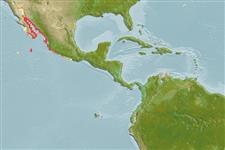Issue
Type locality: Baja California Sur, Inner Gorda Bank, 23°02'N, 109°31'W.
Environment: milieu / climate zone / depth range / distribution range
Ecology
Marine; reef-associated; depth range 8 - 55 m (Ref. 58018). Tropical; 33°N - 14°N, 115°W - 98°W (Ref. 5222)
Eastern Central Pacific: Gulf of California south to Jalisco, Mexico.
Size / Weight / Age
Maturity: Lm ? range ? - ? cm
Max length : 105 cm TL male/unsexed; (Ref. 40637); max. published weight: 14.1 kg (Ref. 40637)
Dorsal spines (total): 11; Dorsal soft rays (total): 16 - 18; Anal spines: 3; Anal soft rays: 10 - 12. Distinguished by the following characteristics: adults with pale grey to brown with purplish tint underwater; body, median fins and rear part of the head covered with small dark reddish brown spots; faint irregular dark spots on dusky pectoral and pelvic fins; dusky blotches on the dorsolateral part of the body; angular preopercle, with serrate lobe at the angle; posterior nostrils not greatly enlarged in adults; rear margin of caudal fin scalloped, with exserted rays (Ref. 89707).
Found on rocky reefs. Common on fields of large boulders with gorgonians and black corals. Feeds on fishes and crustaceans (Ref. 89707).
Life cycle and mating behavior
Maturity | Reproduction | Spawning | Eggs | Fecundity | Larvae
Heemstra, P.C. and J.E. Randall, 1993. FAO Species Catalogue. Vol. 16. Groupers of the world (family Serranidae, subfamily Epinephelinae). An annotated and illustrated catalogue of the grouper, rockcod, hind, coral grouper and lyretail species known to date. Rome: FAO. FAO Fish. Synop. 125(16):382 p. (Ref. 5222)
IUCN Red List Status (Ref. 130435: Version 2024-1)
Threat to humans
Harmless
Human uses
Fisheries: subsistence fisheries
Tools
Special reports
Download XML
Internet sources
Estimates based on models
Preferred temperature (Ref.
123201): 19.8 - 27.4, mean 22.9 °C (based on 30 cells).
Phylogenetic diversity index (Ref.
82804): PD
50 = 0.5000 [Uniqueness, from 0.5 = low to 2.0 = high].
Bayesian length-weight: a=0.00933 (0.00426 - 0.02047), b=3.05 (2.88 - 3.22), in cm total length, based on LWR estimates for this Genus-body shape (Ref.
93245).
Trophic level (Ref.
69278): 4.4 ±0.8 se; based on size and trophs of closest relatives
Resilience (Ref.
120179): Very Low, minimum population doubling time more than 14 years (Preliminary K or Fecundity.).
Fishing Vulnerability (Ref.
59153): High vulnerability (63 of 100).
Nutrients (Ref.
124155): Calcium = 20.9 [13.1, 36.4] mg/100g; Iron = 0.455 [0.250, 0.763] mg/100g; Protein = 18.7 [16.8, 20.3] %; Omega3 = 0.127 [0.084, 0.197] g/100g; Selenium = 39.1 [21.5, 72.4] μg/100g; VitaminA = 108 [38, 346] μg/100g; Zinc = 0.766 [0.534, 1.079] mg/100g (wet weight);
